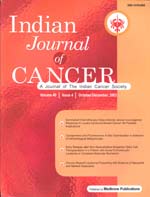
|
Indian Journal of Cancer
Medknow Publications on behalf of Indian Cancer Society
ISSN: 0019-509X
EISSN: 0019-509X
Vol. 48, No. 4, 2011, pp. 391-396
|
 Bioline Code: cn11114
Bioline Code: cn11114
Full paper language: English
Document type: Research Article
Document available free of charge
|
|
|
Indian Journal of Cancer, Vol. 48, No. 4, 2011, pp. 391-396
| en |
Estrogen, progesterone and HER2 receptor expression in breast tumors of patients, and their usage of HER2-targeted therapy, in a tertiary care centre in India
Ghosh, J; Gupta, S; Desai, S; Shet, T; Radhakrishnan, S; Suryavanshi, P; Parmar, V; Jalali, R; Goyal, G; Hawaldar, R; Patil, A; Nair, N & Badwe, R A.
Abstract
Background: This study was undertaken to document the pattern of expression of estrogen (ER), progesterone (PR) and human epidermal growth factor receptor-2 (HER2) and the usage of HER2-targeted therapy in a large tertiary care hospital in India in the year 2008.
Materials and Methods: The histopathology reports of all breast cancer patients registered in the hospital in 2008 were extracted from the electronic medical record system. All the cases were immunohistochemically evaluated for estrogen and progesterone receptor status (ER and PR), and c-erbB-2 protein (HER2) expression using standard immunoperoxidase method. The use of HER2-targeted therapies was evaluated by extracting relevant information from the database of the hospital pharmacy and case charts of patients enrolled in ongoing approved trials.
Results: A total of 2001 new patients of invasive breast cancers with available pathology reports were registered in the hospital in the year 2008. ER and/or PR expression was positive in tumors of 1025 (51.2%) patients. HER2 3+ expression by immunohistochemistry (IHC) was found in 335 (16.7%) and HER2 2+ in 163 (8.1%). The triple negative phenotype was found in 596 (29.8%) patients. An estimated 441 patients were eligible to receive HER2-targeted therapy based on their HER2 status. Of these 38 (8.6%) patients received some form of HER2-targeted therapy; 20 patients (4.5%) as part of ongoing clinical trials and 18 (4.1%) as part of routine care.
Conclusions: The overwhelming majority of patients eligible for HER2-targeted therapy in our institution are unable to receive it because of financial constraints and limited access to health insurance. There is a higher fraction of patients with the triple negative phenotype compared to the Western population.
Keywords
HER2-targeted therapy, India, triple negative
|
| |
© Copyright 2011 - Indian Journal of Cancer
Alternative site location: http://www.indianjcancer.com/
|
|
